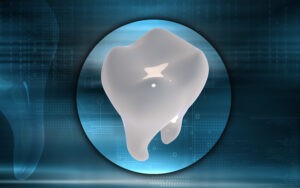Traditionally, pulp sensibility tests have helped form the basis of clinical endodontic diagnoses. During an examination, the clinician performs tests to elicit a response from the patient. This indicates whether they may have clinical signs of pulpitis/pulp necrosis.
These tests have been used for many years, and have a place in modern endodontics. However, they are often subjective, which can make the results difficult to measure. Clinicians should consider the impacts that digital technology could have on endodontic diagnostics.

Traditional pulp testing: benefits and challenges
Pulp testing is traditionally used to assess the neural response of the dental pulp. These tests include temperature, electric, and percussion tests. Each of these reveals different information about the pulp, and have their own strengths and weaknesses.
For the best results, clinicians should first test a control tooth, which they believe to be healthy. This is to ascertain a normal response, in order to recognise an abnormal response for each patient.[i]
Cold testing
The British Endodontic Society’s (BES) Guide to Good Endodontic Practice says cold testing should be used as a first line evaluation.[ii] The results of a cold test indicates both pulp vitality and the condition of the pulp. In this type of test, a positive response indicates vitality, whilst a negative response may indicate pulp necrosis in some cases.[iii]
Electric pulp testing
Electric pulp testing is carried out using an electric pulp tester (EPT). It flows a high frequency electrical current from the probe tip through the tooth. Whilst a positive response indicates vital pulp tissue, it does not signal pulpal health. A negative result, however, reveals pulp necrosis.[iv]
Percussion testing
Percussion tests can be used to accurately identify the effected tooth when the disease affects the periodontal ligament. Clinicians should tap gently on the incisal or occlusal surface of the tooth using the blunt end of an instrument. A positive response does not necessarily indicate endodontic disease. Trauma and periodontal disease can also result in sensitivity.[v]
Digital imaging to form a diagnosis and plan treatment
Digital radiographs help with diagnosis, treatment planning, and visualisation of root canals during treatment. CBCT imaging may also be used to support endodontic workflows where appropriate. CBCT images are able to produce an accurate 3D reconstruction of the anatomy. This enables clinicians to more easily understand the structure of the root canals.[vi]
Guided endodontics
Guided endodontics is a technique which is still evolving.[vii]
Static guided endodontics requires a CBCT image and dental impression to create a surgical guide to cover the teeth in the area. It is thought that static guided endodontics results in shorter treatment times for patients. It also improves accuracy and safety when compared to conventional treatment. However, time is required to create the guides, and they are only effective for straight canals.[viii]
Dynamic guided endodontics uses CBCT images with the help of a camera connected to a dynamic navigation system. This technique is more ergonomic, and allows adjustments and repositioning to be made in real time. It is accurate and can be used on multi rooted teeth. Clinicians need extra training to be competent in using this technique for the best results.[ix]
Looking to the future
The implementation of digital technology in the endodontic field so far is promising. It allows clinicians to more accurately diagnose and treat endodontic infections. Looking to the future, we can anticipate the introduction of more digital tools. These will further improve endodontic workflows and diagnostic procedures, and improve the longevity of treatment results.

Author: Alyn Morgan
[i] The journal of multidisciplinary care decisions in dentistry. Principles of endodontic diagnosis. Accessed May 24. https://decisionsindentistry.com/article/principles-endodontic-diagnosis/
[ii] British Endodontic Society. Guide to good endodontic practice. Accessed May 24. https://britishendodonticsociety.org.uk/news/39/a_guide_to_good_endodontic_practice/
[iii] The journal of multidisciplinary care decisions in dentistry. Principles of endodontic diagnosis. Accessed May 24. https://decisionsindentistry.com/article/principles-endodontic-diagnosis/
[iv] The journal of multidisciplinary care decisions in dentistry. Principles of endodontic diagnosis. Accessed May 24. https://decisionsindentistry.com/article/principles-endodontic-diagnosis/
[v] The journal of multidisciplinary care decisions in dentistry. Principles of endodontic diagnosis. Accessed May 24. https://decisionsindentistry.com/article/principles-endodontic-diagnosis/
[vi] British Endodontic Society. Guide to good endodontic practice. Accessed May 24. https://britishendodonticsociety.org.uk/news/39/a_guide_to_good_endodontic_practice/
[vii] Kulinkovych-Levchuk K, Pecci-Lloret MP, Castelo-Baz P, Pecci-Lloret MR, Oñate-Sánchez RE. Guided Endodontics: A Literature Review. Int J Environ Res Public Health. 2022 Oct 26;19(21):13900. doi: 10.3390/ijerph192113900. PMID: 36360780; PMCID: PMC9657991.
[viii] Kulinkovych-Levchuk K, Pecci-Lloret MP, Castelo-Baz P, Pecci-Lloret MR, Oñate-Sánchez RE. Guided Endodontics: A Literature Review. Int J Environ Res Public Health. 2022 Oct 26;19(21):13900. doi: 10.3390/ijerph192113900. PMID: 36360780; PMCID: PMC9657991.
[ix] Kulinkovych-Levchuk K, Pecci-Lloret MP, Castelo-Baz P, Pecci-Lloret MR, Oñate-Sánchez RE. Guided Endodontics: A Literature Review. Int J Environ Res Public Health. 2022 Oct 26;19(21):13900. doi: 10.3390/ijerph192113900. PMID: 36360780; PMCID: PMC9657991.